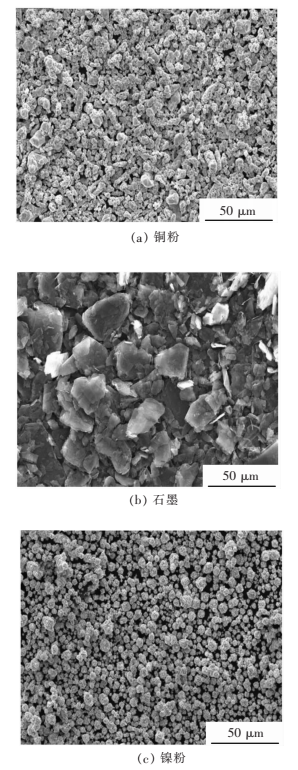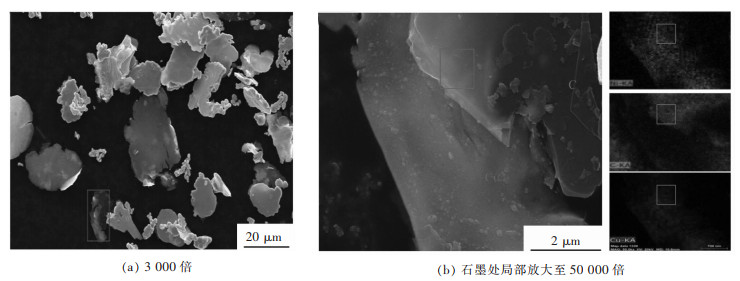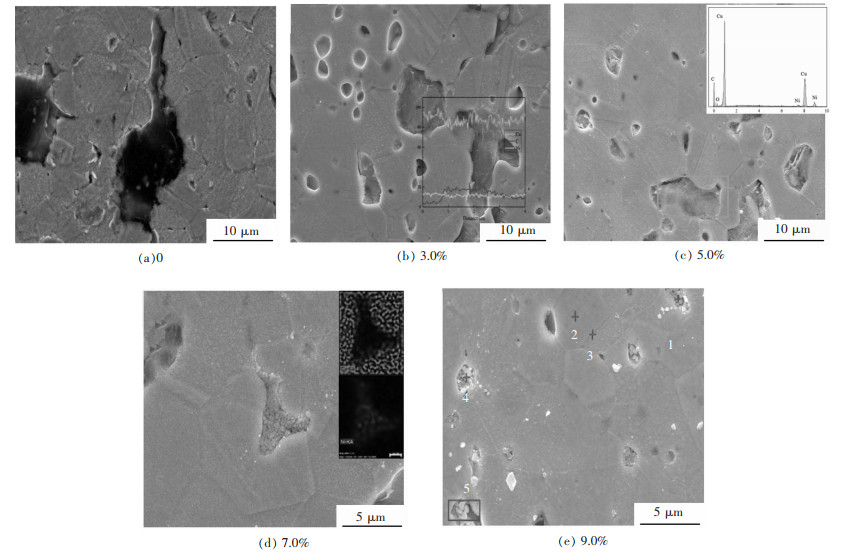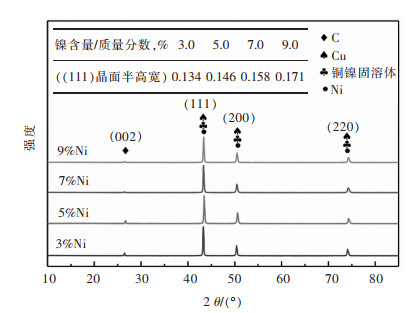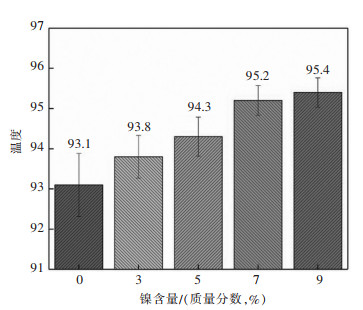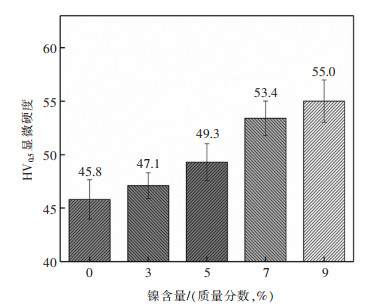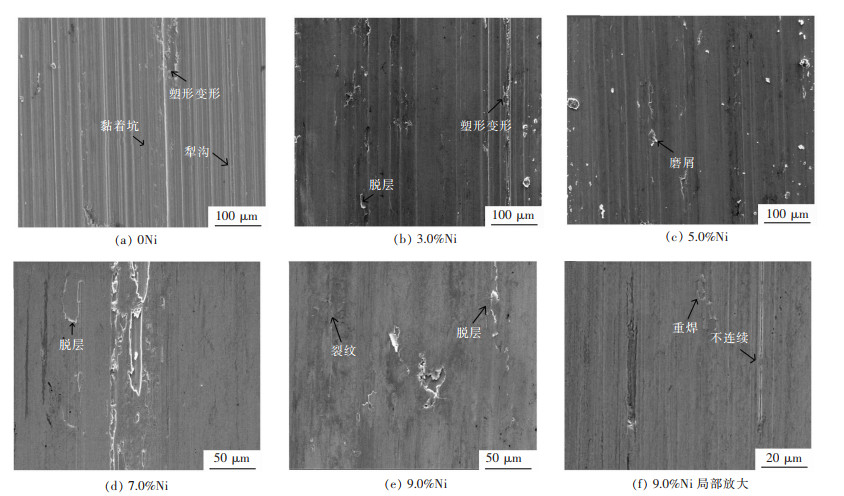Study on the microstructure and properties of nickel-doped graphite-copper composites prepared by spark plasma sintering
-
摘要: 通过超声波分散结合行星球磨对复合粉末进行混料,利用放电等离子烧结技术(SPS)制备镍掺杂石墨-铜复合材料。运用扫描电子显微镜(SEM)、X射线衍射(XRD)、硬度计和摩擦磨损试验机等方法,研究了不同镍掺杂含量对石墨-铜复合材料组织和力学性能的影响。结果表明:通过该工艺制备石墨-铜复合材料石墨均匀分散于铜基体,并与铜基体形成良好的界面结合。随着镍掺杂含量的增加,石墨-铜复合材料相对密度和硬度逐渐增加。当镍掺杂含量(指质量分数)为7.0%时,石墨-铜复合材料相对密度为95.2%,HV0.5硬度为53.4,摩擦系数相对较低,磨损表面较光滑,此时综合性能较好。Abstract: In this paper, the copper powder and graphite power were mixed by ultrasonic dispersion and planetary ball milling, and nickel-doped graphite-copper composites were prepared by spark plasma sintering technology (SPS). The effects of different contents of nickel on the structure and mechanical properties of graphite-copper composites were studied by scanning electron microscope (SEM), X-ray diffraction (XRD), hardness tester, friction and wear tester. The results showed that the graphite was evenly dispersed in the copper matrix and formed a good interface with it. As the content of nickel increased, the relative density and hardness of graphite-copper composites gradually increased. When it reached 7.0 %, the overall performance of the graphite-copper composites proved to be the best with a relative density of 95.2%, a hardness HV0.5 of 53.4, a relatively low friction coefficient and a smooth wear surface.
-
Keywords:
- graphite /
- copper matrix /
- nickel doping /
- SPS /
- friction and wear
-
锌精矿是生产金属锌粉、系列含锌化合物等的重要工业原料。如何精确且快速地测定锌精矿中锌量,对于锌金属工业的发展具有重要意义[1-3]。当前,相关行业对于锌精矿中锌量测定方法主要是根据锌量的高低来进行选择,锌量的测定主要有EDTA滴定法、ICP-AES法、极谱法、X射线荧光光谱法、原子吸收法等[4-5],其中锌精矿中一般锌量的范围在30 %~60 %,目前行业内则采用GB/T 8151.1-2012中的方法以EATD滴定法[6-8]分析,但是在实际的分析检测过程中,不难发现,该方法操作过程复杂,且进行两次沉淀过滤,滤液体积较大,后期处理比较费时,同时在对沉淀进行溶解,以及第二次沉淀过滤过程中,很容易造成损失,导致结果偏低[9]。文中以国标方法为基础,通过盐酸、硝酸和硫酸进行样品的分解,在加入氯化铵的条件下,生成锌铵络合物,再对沉淀进行过滤、清洗,大部分锌可以很好地留在滤液中,滤液再经过浓缩,按国标方法用EDTA滴定,便可得出滤液中的锌量[10]。沉淀通过分解、定容,用原子吸收法测得沉淀中残留的锌量。将滤液、沉淀中的锌量加和,再扣除样品中镉的当量值,便可得出精矿中的最终锌量,整个分析过程锌的量在一个闭环中进行检测,基本不存在损失的情况,且操作上更为简单、便捷[11]。
1 实验部分
1.1 改进方法的原理
试样参照GB/T 8151.1-2012进行溶解沉淀后,经过滤,滤液进行浓缩后用EDTA滴定,测定出滤液中的锌量,过滤后,第一次的沉淀物经酸解,定容,经原子吸收法测定出沉淀中的锌量,两部分的锌量加和,再减去镉的当量值,即可测定出样品中最终锌量。
1.2 主要仪器及工作条件
Thermo Scientific iCE-3300原子吸收光谱仪,赛默飞世尔科技公司;AL204型电子天平,梅特勒-托利多仪器(上海)有限公司;锌、镉空心阴极灯。仪器的工作参数见表 1。
表 1 ICE-3300原子吸收光谱仪工作条件Table 1. The working condition of atomic ICE-3300 absorption spectrophotometer
1.3 主要试剂与药品
洗涤液:2 g氯化铵溶于100 mL水中,再滴加3滴氨水,混匀、过硫酸铵(200 g/L)、氟化钾(200 g/L)、硫代硫酸钠(100 g/L)、乙酸-乙酸钠缓冲液(pH 5.5)、锌标准贮存溶液(100 mg/mL,由金属锌制得)、锌标准溶液(10 μg/mL).镉标准溶液(10 μg/mL)、硫酸铁(100 g/L)、甲基橙(0.5 g/L)、二甲酚橙(5 g/L)。盐酸(ρ1.19 g/mL)、硝酸(ρ1.42 g/mL)、硫酸(ρ1.84 g/mL)、氨水(ρ0.90 g/mL)、氯化铵、抗坏血酸。
1.4 配制及标定Na2EDTA标准溶液
1)配制:称取37.2 g乙二胺四乙酸二钠,用水溶解,冷却至室温,再定容至2 000 mL容量瓶中,摇匀,放置3~5天。
2)标定:移取10 mL锌标准储备液于300 mL烧杯中,在溶液中加入0.1 g抗坏血酸,滴入1~2滴甲基橙指示剂,再加入氨水(1+1)和盐酸(1+1),使溶液颜色恰好变成红色后,加入20 mL乙酸-乙酸钠缓冲溶液、5 mL氟化钾溶液、10 mL硫代硫酸钠溶液,最后滴入3滴二甲酚橙指示剂,滴入Na2EDTA标准液使溶液颜色由紫红色变为亮黄色结束,平行3份,并随同标定作空白试验。按公式(1)计算Na2EDTA标准溶液的滴定度,结果保留四位有效数字:

(1) 式(1)中:c为锌标准储备液浓度,mg/mL;v为锌标准储备液体积,mL;v1为标定锌标准储备液所消耗Na2EDTA标准溶液的体积,mL;v0为标定空白所消耗EDTA标准溶液的体积,mL。
1.5 改进方法测试样锌量实验步骤
1)准确称取0.20 g试样至300 mL烧杯中,精确至0.000 1 g,加入10 mL盐酸溶液,加盖表面皿,低温溶解以驱赶硫化氢8 min,再加入5 mL硝酸加热至试样分解并且冒棕红色烟时取下,冷却,再加入2.5 mL硫酸,高温分解至呈湿盐状,冷却。
2)加入2 mL硫酸,吹入约60 mL蒸馏水,加热煮沸至盐类溶解,取下稍冷,并适当补加硫酸铁,再加入4 g氯化铵固体,5 mL过硫酸铵溶液,边搅拌边加氨水至沉淀完全再过量10 mL氨水,加热微沸。
3)趁热用快速定性滤纸过滤,用热的氯化铵-氨水洗液洗涤烧杯4~5次,沉淀7~8次,滤液用300 mL烧杯收取。将滤液置于电炉上加热浓缩至100 mL左右,冷却,按上述标定方法滴定溶液,记下所消耗Na2EDTA标准溶液的体积[12],代入公式(1),计算出滤液中的锌量。
4)将沉淀连同滤纸置于原烧杯中,加入20 mL硝酸、5 mL高氯酸,置于电热板上加热分解使呈湿盐状,取下冷却,再用水洗杯壁和表面皿,加热溶解盐类[13],冷却,定容至200 mL容量瓶中,加入15 mL硝酸,使用空气-乙炔火焰,于原子吸收光谱仪波长213.9 nm处[14],与标准溶液系列同时测定沉淀中锌的吸光度,再扣除空白吸光度,从工作曲线查出沉淀中相应的锌量[15]。
5)工作曲线的绘制。分别取0、1、3、5、10 mL锌标准溶液置于一组100 mL容量瓶中,各加入7.5 mL硝酸溶液,以水稀释至刻度,混匀。
6)按以上步骤做随行作空白试验,同时参照GB/T 8151.8-2012测出试样中镉量[16],由滤液中锌量和沉淀中锌量加和再减去镉量,即为试样的最终锌量[17]。
2 结果与讨论
2.1 改进方法沉淀中的锌量和各试样镉量的测定结果
采用改进方法于原子吸收光谱仪上测定1#~5#锌精矿试样沉淀中锌量以及各试样的镉量,以及镉量相当于锌的当量值,结果见表 2。
表 2 锌精矿试样沉淀中锌量和试样中镉量Table 2. Result of zinc content and cadmium content
2.2 改进方法与国标方法测定同一批样品锌量结果比对
分别采用国标法和改进方法对1#~5#锌精矿试样以及标样GW07168进行锌量的测定,均为扣除Cd后结果,见表 3,其中改进方法的结果表示为滤液和沉淀锌量之和,国标方法结果为2次过滤后滤液的滴定计算结果。改进的方法测定的锌量与国标法测定的结果在误差范围内,并且测定结果整体性略高于国标法测定的结果。同时通过应用改进方法对标准样GW07168的锌量进行测定,其锌量的均值为52.68%,且结果的重现性较好,与GW07168的锌量的标准值52.70%在误差允许范围内,这就进一步表明该改进的方法可靠。
表 3 锌精矿中锌量测定本方法与国标方法结果比对Table 3. Results of different methods
同时对1#~5#样品中按国标方法处理的二次过滤后的未计入考虑的残渣以及过滤所用的滤纸一并进行分解、定容,测定其中的锌量,测定结果见表 4。按照国标方法进行二次过滤并且反复清洗的情况下,仍有少量的锌残留在沉淀未完全清洗至滤液中,通过补偿修正后不难发现,修正后的总计锌量与改进方法测定的锌量值基本一致,从而进一步证明,改进的方法在结果保证准确的同时,操作的便捷性要优于国标方法。
表 4 国标方法中二次过滤后沉淀中锌量测定结果Table 4. Zinc content of residue using GB/T 8151.1-2012
2.3 改进方法的精密度
选取3个锌精矿样品,按照改进方法进行11次重复试验测定其锌量,根据测量数据计算标准偏差(SD)和相对标准偏差(RSD),结果见表 5。
表 5 精密度实验结果Table 5. Results of precision experiments
2.4 改进方法的准确度
采用改进方法对样品2#分别加入不同量的锌标,测定其回收率,见表 6。结果表明,该改进方法测定锌量的回收率在95%~105%之间,满足测定要求。
表 6 准确度试验结果Table 6. Results of accuracy
2.5 改进方法试验讨论
1)国标方法中,在溶解样品过程中采用的是加入5 mL硫酸(1+1)冒烟分解,但在实际分析过程中,易出现样品溅跳,并且配置硫酸(1+1)如操作不当,容易出现危险,因此在该方法中采用2.5 mL硫酸(ρ1.84 g/mL)硫酸冒烟分解,可防止样品溅跳导致结果偏低,同时可避免配置硫酸(1+1)的潜在危险。
2)国标方法中,采用的是两次沉淀与分离,少量多次采用热的氨水-氯化铵洗液洗涤沉淀,已达到尽可能将沉淀中吸附的锌元素洗到滤液中去的效果,防止结果偏低。在实际分析过程中,因为洗涤的次数较多,而且一般沉淀也比较多,不好控制滤液的体积,同时在洗涤过程中很难将吸附在沉淀里的锌元素完全洗除。不仅导致滤液后期处理费时,还可造成由于未能彻底洗净沉淀中的锌导致锌精矿中锌量偏低。所以,该法将样品中的锌元素完全锁定在一个闭环中,通过分别测定滤液和沉淀中的锌量,将滤液滴定的结果和沉淀测定的结果加和,再减去镉的当量值,得出最终锌量。消除沉淀中吸附的锌元素引起结果偏低,而且也方便控制滤液体积,大大缩短了浓缩滤液体积的时间。
3)在改进的实验中,沉淀选择用原子吸收法测定,是因为经过过滤和多次的清洗,大部分的锌已经转移到滤液中,少量的锌残留沉淀中,此时选用原子吸收法可以保证沉淀中锌量结果的准确性以及快速测定。
3 结束语
文中所改进的分析方法是以国标GB/T 8151.1-2012为基础,通过两种不同的分析手段分别测定滤液和沉淀中的锌量,两者加和,减去样品中的镉的当量值,即为最终锌量。该方法既避免了二次沉淀与过滤,以及由于未将残渣清洗干净导致锌残留在滤渣中引起的结果偏低,又能很好地控制滤液的体积,节约分析检测的时间。
-
表 1 图 4(e)对应能谱的元素分布
Table 1 Figure 4(e) element distribution of the energy spectrum

-
[1] WANG Q, CHEN M, SHAN Z, et al. Comparative study of mechanical and wear behavior of Cu/WS2 composites fabricated by spark plasma sintering and hot pressing[J]. Journal of Materials Science & Technology, 2017, 33(11): 1416-1423. http://www.wanfangdata.com.cn/details/detail.do?_type=perio&id=clkxjsxb-e201711026
[2] ELKADY O A M, ABU-OQAIL A, EWAIS E M M, et al. Physico-mechanical and tribological properties of Cu/h-BN nanocomposites synthesized by PM route[J]. Journal of Alloys and Compounds, 2015, 625: 309-317. http://www.wanfangdata.com.cn/details/detail.do?_type=perio&id=c76eb50dab9c43ee040a58654b300ed8
[3] XU E, HUANG J, LI Y, et al. Graphite cluster/copper-based powder metallurgy composite for pantograph slider with well-behaved mechanical and wear performance[J]. Powder Technology, 2019, 344: 551-560. http://www.wanfangdata.com.cn/details/detail.do?_type=perio&id=a949854654ab42f911345d7aceae3704
[4] KOVACIK J, EMMER S, BIELEK J, et al. Effect of composition on friction coefficient of Cu-graphite composites[J]. Wear, 2008, 265(3/4): 417-421. doi: 10.1016-j.wear.2007.11.012/
[5] AYYAPPADAS C, MUTHUCHAMY A, ANNAMALAI A R, et al. An investigation on the effect of sintering mode on various properties of copper-graphene metal matrix composite[J]. Advanced Powder Technology, 2017, 28(7): 1760-1768. http://www.wanfangdata.com.cn/details/detail.do?_type=perio&id=9e1cb44b2d35d8eb26f408fadd1b7c8d
[6] ZOU H, RAN X, ZHU W, et al. Tribological behavior of copper–graphite composites reinforced with cu-coated or uncoated SiO2 particles[J]. Materials, 2018, 11(12): 2414. http://d.old.wanfangdata.com.cn/NSTLQK/NSTL_QKJJ0213585560/
[7] RAJKUMAR K, ARAVINDAN S. Tribological performance of microwave sintered copper-TiC-graphite hybrid composites[J]. Tribology International, 2011, 44(4): 347-358. http://www.wanfangdata.com.cn/details/detail.do?_type=perio&id=17bd022b8186c138bc3608d5b56d2ff9
[8] KENNEDY A R, WOOD J D, WEAGER B M. The wetting and spontaneous infiltration of ceramics by molten copper[J]. Journal of Materials Science, 2000, 35(12): 2909-2912. http://www.wanfangdata.com.cn/details/detail.do?_type=perio&id=cd9c14000ec084cc04b0a70aad4e52fe
[9] ZHOU X, CHEN L, CAO H, et al. Effects of emulsified asphalt on the mechanical and tribological properties of copper/graphite composites[J]. Materials Research Express, 2019, 6(5):1-16. http://www.wanfangdata.com.cn/details/detail.do?_type=perio&id=IOP_9484185
[10] HE J, ZHANG H, ZHANG Y, et al. Effect of boron addition on interface microstructure and thermal conductivity of Cu/diamond composites produced by high temperature-high pressure method[J]. Physica Status Solidi (a), 2014, 211(3): 587-594. http://www.wanfangdata.com.cn/details/detail.do?_type=perio&id=a3b875a4f9855979a98facef5169cf85
[11] NAYAK D, DEBATA M. Effect of composition and milling time on mechanical and wear performance of copper-graphite composites processed by powder metallurgy route[J]. Powder Metallurgy, 2014, 57(4): 265-273. http://www.wanfangdata.com.cn/details/detail.do?_type=perio&id=faa2d039870bb907cb9c3a4337c47c29
[12] SAMAL C P, PARIHAR J S, CHAIRA D. The effect of milling and sintering techniques on mechanical properties of Cu-graphite metal matrix composite prepared by powder metallurgy route[J]. Journal of Alloys and Compounds, 2013, 569: 95-101. http://www.wanfangdata.com.cn/details/detail.do?_type=perio&id=0da420fa93543a1233c49710cfddab50
[13] 张雪辉, 章标, 朱太恒, 等. W-4.9Ni-2.1Fe高比重合金的摩擦磨损行为[J].有色金属科学与工程, 2016, 7 (4): 33-39. http://ysjskx.paperopen.com/oa/DArticle.aspx?type=view&id=20160406 [14] 徐唱, 罗江斌, 彭弯弯, 等. NASICON型固体电解质Li1.1Y0.1Zr1.9(PO4)3的SPS烧结及性能研究[J].有色金属科学与工程, 2018, 9(1): 66-70. http://www.wanfangdata.com.cn/details/detail.do?_type=perio&id=jxysjs201801011 [15] SHANAGHI A, CHU P K, XU R, et al. Structure and properties of TiC/Ti coatings fabricated on NiTi by plasma immersion ion implantation and deposition[J]. Vacuum, 2013, 89: 238-243. https://www.researchgate.net/publication/256911966_Structure_and_properties_of_TiCTi_coatings_fabricated_on_NiTi_by_plasma_immersion_ion_implantation_and_deposition
[16] WANG Q X, LIANG S H. Investigation on preparation and diffusion barrier properties of W-Ti thin films[J]. Vacuum, 2011, 85(11): 979-985. http://www.wanfangdata.com.cn/details/detail.do?_type=perio&id=5e1ab3a54aa2c3c77c41045aec66e68d
[17] ZHANG R, HE X, CHEN Z, et al. Influence of Ti content on the microstructure and properties of graphite flake/Cu-Ti composites fabricated by vacuum hot pressing[J]. Vacuum, 2017, 141: 265-271. http://www.wanfangdata.com.cn/details/detail.do?_type=perio&id=912bea9e638deeaa9eed2b41df580358
[18] YE Y, RAN X, DONG B, et al. Effect of graphite content on the tribological properties of Cu-Graphite-SiO2 composites[C]//Chinese Materials Conference Springer, Singapore, 2017: 899-909.
[19] 尹延国, 杜春宽, 郑治祥, 等.镀镍石墨粉对铜基石墨复合材料力学性能的影响[J].中国有色金属学报, 2006, 16(11): 1895-1901. http://d.old.wanfangdata.com.cn/Periodical/zgysjsxb200611011 [20] 姚冠新, 牛华伟.镍对铜基粉末冶金摩擦材料摩擦磨损性能的影响[J].热加工工艺, 2016, 45(8):121-124. http://www.wanfangdata.com.cn/details/detail.do?_type=perio&id=rjggy201608032 [21] 余亚岚, 袁楠, 江丹露, 等.镍与石墨含量对新型铜基粉末冶金受电弓滑板材料性能的影响[J].粉末冶金材料科学与工程, 2015, 20(3): 419-424. http://d.old.wanfangdata.com.cn/Periodical/fmyjclkxygc201503014 [22] 李宏伟, 张孟珂.微颗粒制备Cu-Ni二元合金及性能研究[J].热处理技术与装备, 2019, 40(4): 8-11. http://d.old.wanfangdata.com.cn/Periodical/gwjsrcl201904002 [23] YUAN Y, GAN X, LAI Y, et al. Microstructure and properties of graphite/copper composites fabricated with Cu-Ni double-layer coated graphite powders[J]. Composite Interfaces, 2019: 27(3):1-15. http://www.wanfangdata.com.cn/details/detail.do?_type=perio&id=10.1080/09276440.2019.1644051
[24] TANG Y, YANG X, WANG R, et al. Enhancement of the mechanical properties of grapheme-copper composites with grapheme-nickel hybrids[J]. Materials Science and Engineering: A, 2014, 599: 247-254. https://www.sciencedirect.com/science/article/pii/S0921509314000926
[25] WANG Y, GAO Y, LI Y, et al. Research on nickel modified graphite/Cu composites interface[J]. Surface and Coatings Technology, 2017, 328: 70-79. http://www.wanfangdata.com.cn/details/detail.do?_type=perio&id=728fc0d1c6f86536a5e1130d6a8b92f0
[26] WANG Y, GAO Y, SUN L, et al. Effect of physical properties of Cu-Ni-graphite composites on tribological characteristics by grey correlation analysis[J]. Results in Physics, 2017(7): 263-271. http://cn.bing.com/academic/profile?id=5fe545c2da93392546ba6e57cdffae8a&encoded=0&v=paper_preview&mkt=zh-cn
-
期刊类型引用(2)
1. 陆迁树,叶元顺,王银剑,刘振超,陈金伟. EDTA配位滴定法在野外检测多金属矿石中锌量的应用. 岩矿测试. 2024(05): 812-820 .  百度学术
百度学术
2. 田景春,杨爱红,田江锋,宋志红,李力. 电解锌生产原材料中锌的分析方法改进. 湖南有色金属. 2023(01): 87-90 .  百度学术
百度学术
其他类型引用(1)



 下载:
下载:
